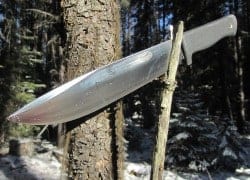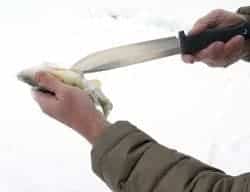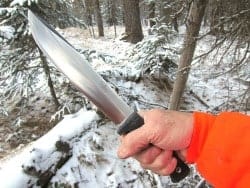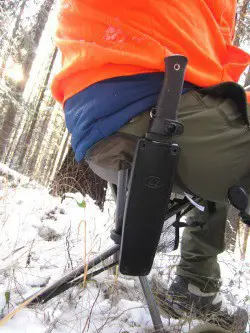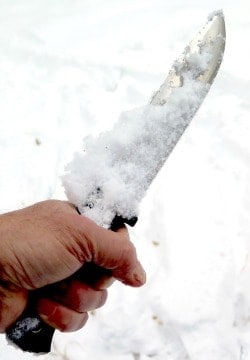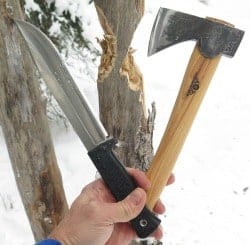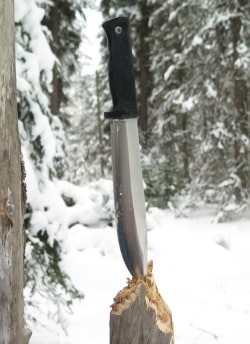Peter, the head of Fällkniven knives told me that a big blade can do everything a small blade can do, but a small blade cannot do everything a big blade can do. Or thereabouts.
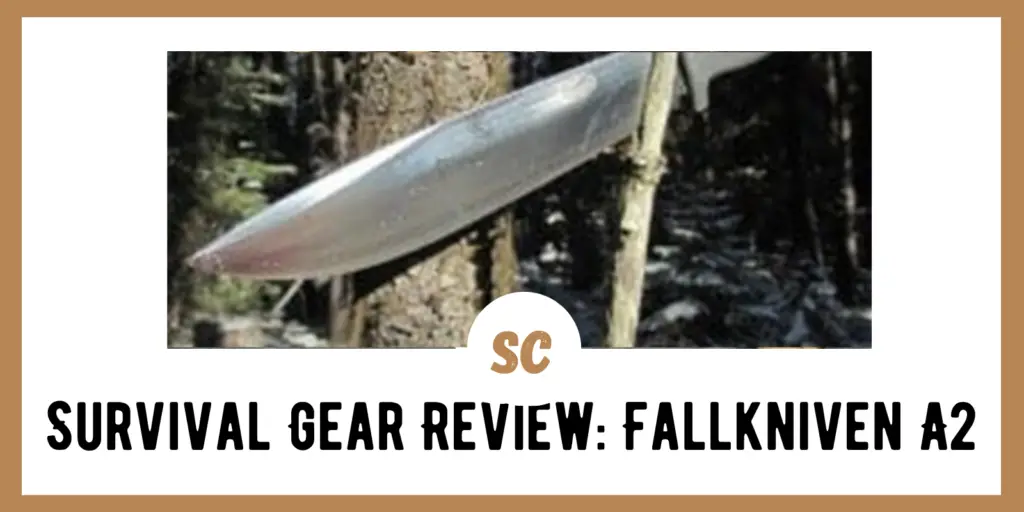
In theory, I agree with him. But in practice…well, that would take field testing. Big is not a measurement, it is a value judgment. If you need a 22mm wrench, then you need a 22mm wrench. The tool is not too big, it is just right. However, if you have no particular job in front of you, then carrying around the wrench for no particular reason would make it seem “big.”
SKIP AHEAD
Carry Enough Knife
The same is true with the Fällkniven A2 Wilderness Knife. If you have no real need for a knife such as the A2, then you might as well carry a smaller, lighter knife. Heck, or even no knife at all. Heresy you say?
Well that is my point. You carry a knife that matches your anticipated duties. So it follows that a Wilderness Knife such as the Fällkniven A2 is the properly sized tool for the great big outdoors found just past the “great outdoors” common in movies and national parks.
Beyond the usual depth that most folks ever venture into the woods is an entirely new, bigger, and often scarier set of woods. It is the uninhabited, trail-less frontier where the only certainty in the equation is that your survival skills must outweigh the survival challenges. And while tools don’t equal skills, the lack of tools can certainly subtract from your skill set.
- Handle Color: Black
Last update on 2024-04-24 at 16:12 / Affiliate links / Images from Amazon Product Advertising API
Size Matters
The absurdity of the so-called “Rambo blade” comes more from attitude and knife design than knife size and intended use. Nobody pokes fun about the size or length of kitchen knives because they are the right tool for the job.
Yet compared to most outdoor knives, kitchen blades are downright huge! Especially the pro-level cutters. The Rambo knife moniker is often reserved not for just the knife but instead a knife too big for the tasks at hand. So a true wilderness knife like the Fällkniven A2 is actually the right size for the job so therefore it is not a Rambo knife. The A2 is a properly sized tool for the bigger pieces of the big picture. Of course, that means it’s not for everybody.
History Lesson: Blade Thickness and Materials
Over a decade ago, Fällkniven took a page from the Swedish history book and explored the strength of laminated steels. For the same reason plywood is so much stronger than a similar thickness solid board or laminated glass windshields are intensely durable compared to household window glass, the layered steel in the Fällkniven A2 is massively stronger than most any other steel of similar thickness.
Fällkniven worked with a famous Japanese steel mill to perfect a laminated metal suitable for the highest quality knife blades. Well, not just any knife blades, but really big knife blades.
Best of Both Worlds
High carbon tool steels such as D2 or O1 are popular for outdoor knives due to their ease of sharpening and resistance to snapping when bent. Stainless steels have many fine points including edge durability, but can chip or break much easier.
So you can do the math. The ideal steel would have the cutting prowess and durability of stainless, but the bending strength and sharpening ease of high carbon steel. By laminating steel types, you get the best of both worlds. Plus the additional raw strength that lamination provides on its own.
Dog Inches
The Fällkniven A2 is not the biggest Fällkniven to ship from Sweden. But it’s close. With a overall length of 12.8 inches and all but 4.9 inches of that being stainless steel VG10 laminated goodness, the A2 is definitely one of the big boys in the sandbox.
The 7.9 inch blade is a full 1.7 inches longer than its famous little brother, the A1. And those 1.7 inches are like dog-inches when you get out to knives like this. It might seem like the added reach looses it’s effect as the blades get longer, but it is not just length where the A2’s blade grew; its also in depth.
Like football players, their height tells only part of the story. You really need their weight in order to appreciate their potential on the field. Some players weigh half again as much as others of the same height. For instance on the Denver Broncos lineup, the difference in height between William Sylvester and Aqib Talib is about the same as between the A2 and the A1. However, Sylvester weighs 108 pounds more than Talib. Which player would you want to be facing off against on the scrimmage line?
But the Fällkniven A2 is not strictly an offensive blade. Instead it is proportioned for the big tasks of Big Wilderness and Big Survival. Especially where you need to wear a big coat, big boots, big gloves and a big hat. When the temperature drops so do our fine motor skills and our grip strength. The A2 helps compensate for the losses by beefing up its contribution to the workload.
When I passed my A2 around the campfire, more than a few folks have commented that it is too big. Avoiding a verbal fight, I usually let the comments slide. But what I really want to ask is “Too big for what?”
As Fällkniven notes in their description of the A2, “When you are far from inhabited areas, you need to be able to rely on your equipment.” I think that make it pretty clear that the A2 was not designed for public carry, or even public campground carry. So when someone is packing an A2, they are probably no where near you. And if you do run into an A2 in the wild, you won’t be making any snide comments about it.
The Usual Suspects
For the record, the blade length of the Fällkniven A2 is only one inch longer than the KA-BAR Marine fighting knife. You know that famous clip-point-leather-washered-grip-soft-steel knife that has multiplied force all over the world.
Other comparables include the big Beckers, the big ESEEs, the big Rats, and the big Cold Steels. Where most of these knives differ from the A2 besides price is in the steel. Most of them are high carbon steel, spring steel, tool steel or common stainless steel.
Nothing wrong any of those unless you want something different. In order to answer the question of the best steel, one must define the landscape where the knife will live.
A Wilderness Knife
As a wilderness knife, the A2 needs to hold an edge as long as possible, but also provide realistic sharpening options. As a chopper, the convex grind provides good wedging for a knife yet resists as much pinching as possible allowing for easy retraction from the wood. As a thick-bladed fighter, the system of handle and blade must be stronger than any man who carries it.
Oddly, however, the A2 would look right at home in the kitchen. As noted before, kitchen knives that dwarf the length of the A2 are available for sale in grocery stores. Quality is a concern, but the size hardly raises any eyebrows. Unfortunately the city dwellers think you have a Crocodile Dundee Complex when you pack a kitchen-sized blade on your hip.
Another friendly juxtaposition is with gardening tools. Most every serious gardener I know rarely ventures into the backyard with a Hori Hori strapped to their pleated cotton shorts.
Hori Hori
A Hori Hori, or soil knife, is a heavy duty, wooden handled, double-edged, half-serrated blade averaging seven inches long with an overall length exceeding a foot with some up to 15 inches long. And the Hori Hori is considered a “Leisure Knife.”
The smooth blade is to be kept razor sharp and the serrated side acts like a root saw. Hori Horis are worn in sheaths just like other belt knives and when sheathed are indistinguishable from wilderness knives like the A2 at a short distance. But up close, it’s obvious why the price of a quality Hori Hori is one-tenth or less of the Fällkniven.
- Handle Color: Black
Last update on 2024-04-24 at 16:12 / Affiliate links / Images from Amazon Product Advertising API
Can You Handle It?
The A2 has exactly the same handle as the A1, as well as sharing the same blade thickness, convex grind, and protruding tang. So if you love the A1 grip, you will be just as happy with the A2.
The typical issues with the A1 grip are its length, thickness, texture and direction of the quillion (finger guard). The usual complaints are the grip is too short, too narrow, and too rough. Sure, everyone is entitled to their opinion, but that opinion should be based on something.
For instance, the “too short” complaint is a comparison between the A2 and something else like another knife. I prefer to appreciate the minimalism of the A2’s grip in that my large/XL hands almost swallow the A2 handle completely, but not quite. So the argument about grip length is really more of “how much extra” is needed since the absolute grip amount is sufficiently matched to a large hand.
In a direct comparison, the Fällkniven A2’s actual usable grip length is longer than the Gerber LMF, the Boker Orca, the Spyderco Bushcraft, and the Benchmade Bushcrafter. And the A2 gip is exactly the same thickness as the Gerber LMF.
The diameter of the grip is also something noted as in need of adjustment. The diameter is a function of both grip depth and thickness. The Gerber’s depth is about a quarter-inch more than the A2, but in my hand feels more like a pistol grip due to the position of my finger joints.
I would describe my grip on the Gerber LMF as more of bending around the handle, while gripping the A2 is decidedly wrapping my hand around it. It is similar to squeezing a trigger or pulling a trigger. And in my hand, I cannot squeeze the Gerber’s handle because it is proportioned inefficiently for the biomechanics of my hand.
I think the complaints about the size of the Fällkniven A2 grip are more of visual perception clouding the actual feel of the knife. If grips were proportioned to blade size, then a machete would have a flagpole-sized grip. And a utility knife would have a pencil-thin handle.
Instead, the grip is proportioned within a narrow range where the human hand works best. Same with hatchet handles, hammers, and other hand tools. Cutting tools rapidly become useless when designers venture out of that range. So an average handle on an large blade looks small and can psychologoically “feel” small.
Regarding the texture of the grip, that is a personal choice. But I will make two comments. The first is that if you have soft office hands you will get blisters after 10 minutes of heavy use. But you will also get blisters from a smooth hickory hatchet handle the first time you do some heavy chopping. Once the tool is part of your routine, your skin will adapt with calluses. Better yet, wear gloves.
Weight For Me
The weight of the Fällkniven A2 is 13 ounces, or 2.3 ounces more than the A1. Thirteen ounces is not a small number for a knife, but it is small compared to many outdoor tools.
A 13 ounce handgun would be an unloaded Glock 42, the smallest Glock made. A 13 ounce hatchet would be a Gransfors Bruks Mini Hatchet. A can of lite beer weighs about 13 ounces. And 13 ounces of Big Macs is less than two of them.
Yet when a 13 ounce knife shows up on a belt, people run around in circles with their hair on fire. Again, a good reason to only wear the Fällkniven A2 in uninhabited areas.
Match Making
An area in need of mention is that in any planned wilderness adventure the Fällkniven A2 will not be traveling alone. Most carriers of the A2 supplement its skills with a smaller knife of both the folding and straight variety. You will get no argument from me about the necessity of a smaller blade, but neither will I let knee-jerk comments blasting big knives go unchallenged.
Survival tools fall along a continuum from small to big, light to heavy, cheap to expensive, and feeble to durable. And those tools can be supported through their combination and contribution to the overall capabilities of the kit.
Every tool is a trade-off that establishes boundaries of use. Where the wilderness knife fits into the scheme of things is that the finer, more delicate points of civilization are absent in the wilderness.
The 800-Pound Gorilla
The thing that always seems to change the course of the discussion about knives is the price. In this case, the price is the similar as other blades within this same knife space of size and quality.
A common knife of this size that is often compared to the Fällkniven A2 is the No products found., but at one third the price. It is easy to question the A2 as a sensible decision with that kind of dollar discrepancy, but what you don’t often read is that Cold Steel makes a high-end Wilderness Knife called the Trail Master but with VG1 steel and a better grip.
Not surprisingly the upgraded Trail Master price is the same as the Fällkniven A2. You see quality and performance cost real dollars regardless of how similar the knife looks to others. If you plan on carrying a knife but never pushing it to its survival limits, then go ahead and carry anything. But when the ball drops and what you have is all you will ever have, then now is not the time to be a poser.
Pass the Baton
Using a knife and a club to beat apart a wooden branch is the popular target task for survival knife tests. The problem is that a survival knife is capable of so much more, and busting up firewood is something almost anything can do…until it breaks.
However, a true wilderness knife such as the Fällkniven A2 is exactly designed to baton firewood.
The advantage of batoning over using a hatchet is that the swinging of a hatchet or axe blade is only as accurate as the skill and luck of the user. However, if one can place the cutting blade exactly where it’s needed and then apply the force, every cut will be as precise as the desired.
For those of us who use use a mechanized hydraulics to “chop” firewood, we know that surgical precision is possible when working around knots, and making custom sized wood for a particular stove or fire application. Batoning is similar but certainly more crude than a smooth well-greased steel wedge sliding gracefully along a track with 20 tons of force behind it.
Convex Edge
The A2 has a convex grind meaning that its slight outward bow towards the cutting edge preventing much of the pinching and binding a flat-sided chopping knife experiences. The curved blade surface just beyond the cutting edge splays the wood apart as the knife sinks in deep, but leaves little metal on the table for the wood to stick to.
Some worry about the sharpening intricacies of a convex grind, but if all you have are rough field sharpening tools or smooth river rocks to polish up the edge, then the convex grind is happy with a gentle roll in the grit as the stone surfs across the blade (or vise versa).
As a wilderness knife, the Fällkniven A2 expects a long time between civilized visits to the dentist. Living outdoors is the A1’s happy place. Again, this is the difference between a survival knife and a wilderness knife.
Under Cover
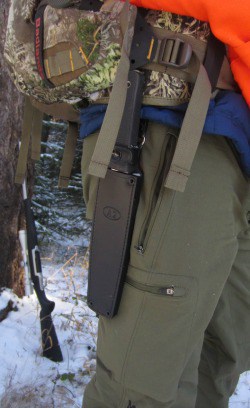
The leather sheath for the A2 is of ambidextrous operation with the single securing snap strap snapping free to the rear when in right-hand carry. Overall, I really like the sheath. It is unassuming and quite functional the dangler easily fits up to three inch belts.
The presentation of the grip while in the sheath is slightly outward from the body meaning it easy to grab. The leather snugs up to the blade holding it in place just fine without the added snap strap for all but the most aggressive gymnastics.
Note that Rambo’s blades in the movies never had extra straps to overcome when deploying his power blade. But also note that the first major knife deployment in the movie First Blood, Rambo yanked his knife free from the sheath and threw the sheath away behind him. Yea, I get that he was in a hurry, but still.
Knife Balance is Important
The balance point of the A2 falls about an inch forward of the grip while the A1 balances right at the forward end of the grip. Not a big difference, but certainly noticeable when chopping into a thick branch.
The A2 is a deliberate chopper and behaves as such. While hacking through branches should be on the resume for all knives, the size of the branch is limited to about two-thirds the length of the blade, and often closer to one-half.
Wrap Up
Sweden, home to the Nobel Prizes, should seriously consider opening a category for Cutlery. But seriously, the degree to which Fällkniven dives into significant knife spaces is impressive not just in scope, but that they pull no punches in quality and performance.
Many blade companies, produce a rich line of edges, but with varying degrees of quality (cough, cough, SOG) and performance (ah-choo, Buck, Kershaw, a-hem). Not that the major brands are lacking, but one cannot simply extend the capabilities of mass-market knives to pro-level survival and wilderness blades. The difference must be experienced to be believed.
- Handle Color: Black
Last update on 2024-04-24 at 16:12 / Affiliate links / Images from Amazon Product Advertising API
All Photos By Doc Montana


